Goat Willow
Salix caprea
Willow family (Salicaceae)
Salix caprea
Willow family (Salicaceae)
Description:
This is a large shrub or small tree that becomes 10–25' tall at
maturity, usually forming a short thick trunk up to 1' across. Trunk
bark of older trees is gray with deep and irregular furrows. In
outline, the crown is obovoid, consisting of many ascending branches,
branchlets, and more divergent twigs. The bark of branches and
branchlets are gray and fairly smooth. Twigs are brown to reddish
brown, smooth, and terete; young twigs are short-pubescent, while older
twigs become hairless. Young growing shoots are light green,
short-pubescent, and terete. The leaves are arranged alternately along
the shoots and twigs. Individual leaves are 2–4½" long, ¾–2" across,
and broadly elliptic in shape; they have margins that are
crenate-serrate, crenate, and/or slightly undulate. The leaf tips are
acute, while the leaf bottoms are wedge-shaped. The upper leaf surface
is medium green, hairless to sparsely short-pubescent, and finely
indented along a network of secondary veins. The lower leaf surface is
white-glaucous and short-pubescent; the latter characteristic is more
pronounced along the primary and secondary veins. The petioles are ¼–½"
long (or slightly longer); they are light green to greenish brown and
short-pubescent. At the base of the petioles of young leaves, there is
a pair
of leafy stipules about ¼" long or slightly longer; each stipule is
half-cordate in
shape with crenate-dentate margins, medium green, and early-deciduous.
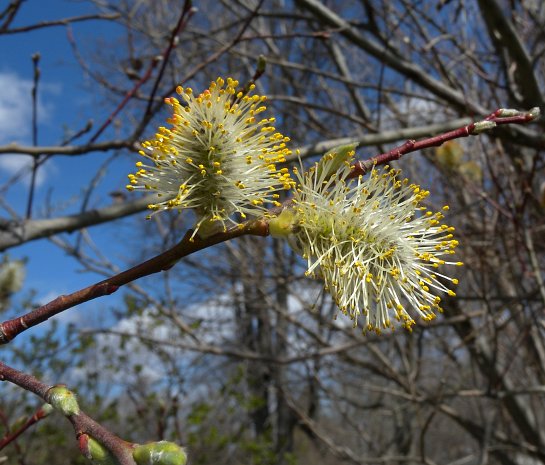
This willow is dioecious with pistillate (female) flowers and staminate (male) flowers occurring on separate shrubs/trees in the form of catkins on last year's twigs. Pistillate catkins are up to 3½" long and semi-erect; each catkin has several spirally arranged pistillate florets along its central stalk. Each pistillate floret has a narrowly pyriform ovary with a short style and pair of stigmas at its apex; the ovary is light green and short-pubescent. At the base of the ovary, there is also a nearly black floral bract (about 3 mm. in length) that is elliptic in shape with a tuft of silky hairs at its base, and a smaller nectary gland. The staminate catkins are up to 1¼" long and erect; each staminate catkin is initially bud-shaped and silky-hairy, but it later becomes more yellowish and fuzzy in appearance from a dense spiral arrangement of maturing staminate florets along its central stalk. Each staminate floret consists of a pair of stamens with yellow anthers. At the base of this floret, there is also a nearly black floral bract (about 3 mm. in length) that is elliptic in shape with a tuft of long silky hairs at its base, and a smaller nectary gland. The blooming period occurs from early to mid-spring before the leaves develop, lasting about 1–2 weeks. Afterwards, the staminate catkins detach from the twigs and wither away, while the pistillate catkins develop mature seed capsules during late spring. Individual capsules are narrowly pyriform in shape, brown, and 8–10 mm. long; they split open to release tiny seeds in cottony tufts of hair. The root system is shallow, spreading, and woody.
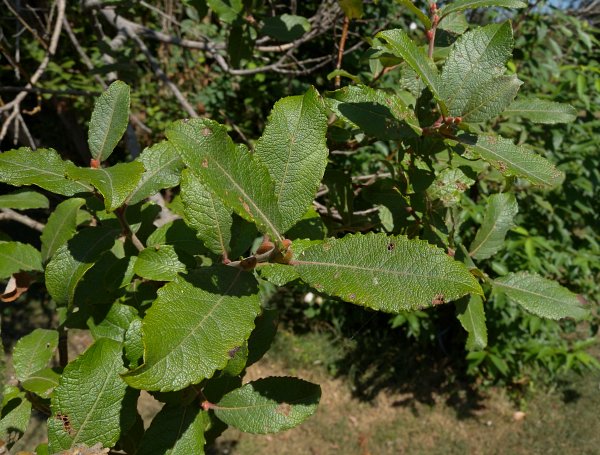
Cultivation: The preference is full or partial sun, moist to mesic conditions, and soil containing silt, loam, or clay-loam with organic matter. Growth is rapid during the late spring and summer. This willow is short-lived, typically surviving for only 15–30 years. Because the spreading root system is attracted to sources of water, it can clog sewer lines and water pipes if it is planted too close to such underground infrastructure. The easiest method of reproduction is through cuttings of last year's twigs, which should be inserted in the ground during late winter or early spring before either the catkins or leaves develop.
Range & Habitat: Goat's Willow (Salix caprea) rarely naturalizes in Illinois, occurring as a wild plant in widely scattered counties (see Distribution Map). One reason for this is that people cultivate primarily staminate (male) specimens of this willow because of their showy silky-hairy catkins during the spring, rather than pistillate (female) specimens. Goat's Willow is native to Europe; it was introduced to North America as an ornamental plant. Habitats of escaped plants in North America include edges of yards, thickets, open floodplain areas, roadsides, areas along railroads, old homestead sites, and waste areas. Areas with a history of disturbance are highly preferred.
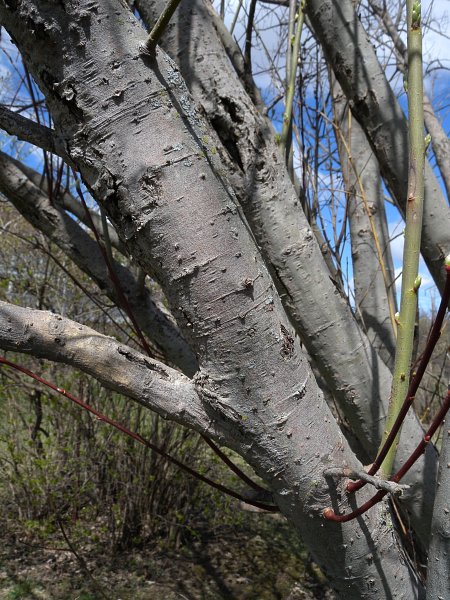
Faunal Associations: The florets of Goat Willow (Salix caprea) and other willows (Salix spp.) attract a wide variety of insects during the spring. Nectar is available as a floral reward in both staminate and pistillate specimens of these willows, and pollen is also available as a floral reward in staminate specimens. These floral visitors include honeybees, bumblebees, little carpenter bees (Ceratina spp.), Halictid bees, cuckoo bees (Nomada spp.), Andrenine bees, Braconid wasps, Ichneumonid wasps, many species of ants, sawflies, Syrphid flies, Tachinid flies, Muscid flies, Calliphorid flies, bee flies (Bombyliidae), miscellaneous beetles, miscellaneous true bugs, and less commonly butterflies that are active early in the spring. Some Andrenine bees are specialist pollinators (oligoleges) of willow flowers; these species include Andrena erythrogaster, Andrena salictaria, Andrena sigmundi, Andrena andrenoides, Andrena illinoiensis, Andrena mariae, and Andrena wellesleyana (Robertson, 1929; Krombein et al., 1979; and others). Other insects feed destructively on the foliage and other parts of Goat Willow and other willows. For example, the following insects have been found to feed on the Goat Willow: an aphid (Plocamaphis flocculosa), leafhoppers (Empoasca andresia, Erythroneura rosa), Willow Scurfy Scale (Chionaspis salicis), and Eurasian Willow Scale (Diaspidiotus gigas); see Blackman & Eastop (2013), Dmitriev & Dietrich (2010), and ScaleNet website (accessed 2014).
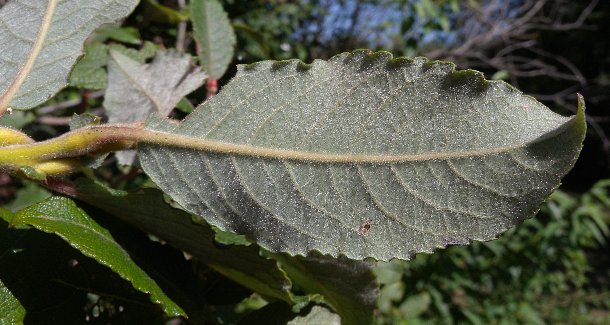
Other insects that feed on this and other willows include larvae of long-horned beetles, leaf beetles, weevils, larvae of leaf-miner flies, larvae of gall flies, plant bugs, stink bugs, spittle bugs, thrips, larvae of sawflies, larvae of many moths, larvae of several butterflies, and larvae of a skipper, the Dreamy Duskywing (Erynnis icelus). Among vertebrate animals, some birds feed on the buds and/or catkins of willows during the spring: this includes the White-crowned Sparrow, Common Redpoll, Evening Grosbeak, and Pine Grosbeak. The Ruffed Grouse also feeds on the leaves and small twigs of willows (DeVore et al., 2004; DeGraaf, 2002; Martin et al., 1951/1961). Mammals that use willows as a source of food include the Fox Squirrel (buds & catkins), American Black Bear (buds, leaves, catkins), Wood Turtle (leaves), American Beaver (wood, bark, near bodies of water), Muskrat (young bark, near bodies of water), Cottontail Rabbit (young bark), White-tailed Deer (twigs, foliage), Prairie Vole (foliage, catkins), and Meadow Vole (foliage, catkins); see Martin et al. (1951/1961), Romain et al. (2013), Ernst et al. (1994), and Lagler (1943).
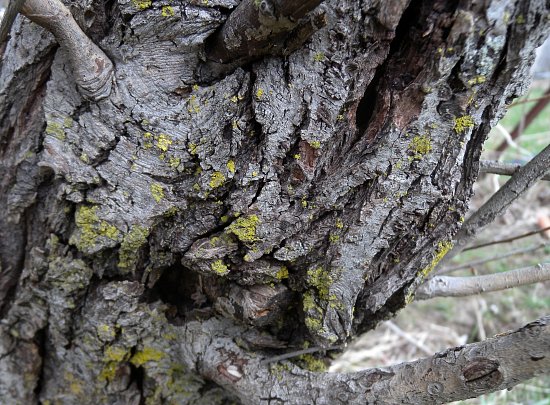
Photographic Location: A yard in Urbana, Illinois.
Comments: This is the 'Pussy Willow' that is typically sold at florist shops for ornamental plant decorations. It is often cultivated as a landscape shrub or tree because of the furry-looking catkins that develop on twigs during the spring. Other willows (Salix spp.) also form furry-looking catkins, but they are smaller in size and less conspicuous. Goat's Willow (Salix caprea) is fairly similar in appearance to a willow species that is native to Illinois, Pussy Willow (Salix discolor). This latter species also produces attractive furry catkins and it can be used as a substitute for the Goat Willow. The native Pussy Willow, however, prefers wetter habitats than the Goat Willow and it is less tolerant to drought. It can be distinguished from the Goat Willow using several characteristics. Overall, Pussy Willow: 1) tends to be a smaller tree or shrub, 2) tends to have smaller leaves, 3) has slightly smaller staminate catkins, and 4) has leaf stipules that are more persistent than those of Goat Willow.

This willow is dioecious with pistillate (female) flowers and staminate (male) flowers occurring on separate shrubs/trees in the form of catkins on last year's twigs. Pistillate catkins are up to 3½" long and semi-erect; each catkin has several spirally arranged pistillate florets along its central stalk. Each pistillate floret has a narrowly pyriform ovary with a short style and pair of stigmas at its apex; the ovary is light green and short-pubescent. At the base of the ovary, there is also a nearly black floral bract (about 3 mm. in length) that is elliptic in shape with a tuft of silky hairs at its base, and a smaller nectary gland. The staminate catkins are up to 1¼" long and erect; each staminate catkin is initially bud-shaped and silky-hairy, but it later becomes more yellowish and fuzzy in appearance from a dense spiral arrangement of maturing staminate florets along its central stalk. Each staminate floret consists of a pair of stamens with yellow anthers. At the base of this floret, there is also a nearly black floral bract (about 3 mm. in length) that is elliptic in shape with a tuft of long silky hairs at its base, and a smaller nectary gland. The blooming period occurs from early to mid-spring before the leaves develop, lasting about 1–2 weeks. Afterwards, the staminate catkins detach from the twigs and wither away, while the pistillate catkins develop mature seed capsules during late spring. Individual capsules are narrowly pyriform in shape, brown, and 8–10 mm. long; they split open to release tiny seeds in cottony tufts of hair. The root system is shallow, spreading, and woody.

Cultivation: The preference is full or partial sun, moist to mesic conditions, and soil containing silt, loam, or clay-loam with organic matter. Growth is rapid during the late spring and summer. This willow is short-lived, typically surviving for only 15–30 years. Because the spreading root system is attracted to sources of water, it can clog sewer lines and water pipes if it is planted too close to such underground infrastructure. The easiest method of reproduction is through cuttings of last year's twigs, which should be inserted in the ground during late winter or early spring before either the catkins or leaves develop.
Range & Habitat: Goat's Willow (Salix caprea) rarely naturalizes in Illinois, occurring as a wild plant in widely scattered counties (see Distribution Map). One reason for this is that people cultivate primarily staminate (male) specimens of this willow because of their showy silky-hairy catkins during the spring, rather than pistillate (female) specimens. Goat's Willow is native to Europe; it was introduced to North America as an ornamental plant. Habitats of escaped plants in North America include edges of yards, thickets, open floodplain areas, roadsides, areas along railroads, old homestead sites, and waste areas. Areas with a history of disturbance are highly preferred.

Faunal Associations: The florets of Goat Willow (Salix caprea) and other willows (Salix spp.) attract a wide variety of insects during the spring. Nectar is available as a floral reward in both staminate and pistillate specimens of these willows, and pollen is also available as a floral reward in staminate specimens. These floral visitors include honeybees, bumblebees, little carpenter bees (Ceratina spp.), Halictid bees, cuckoo bees (Nomada spp.), Andrenine bees, Braconid wasps, Ichneumonid wasps, many species of ants, sawflies, Syrphid flies, Tachinid flies, Muscid flies, Calliphorid flies, bee flies (Bombyliidae), miscellaneous beetles, miscellaneous true bugs, and less commonly butterflies that are active early in the spring. Some Andrenine bees are specialist pollinators (oligoleges) of willow flowers; these species include Andrena erythrogaster, Andrena salictaria, Andrena sigmundi, Andrena andrenoides, Andrena illinoiensis, Andrena mariae, and Andrena wellesleyana (Robertson, 1929; Krombein et al., 1979; and others). Other insects feed destructively on the foliage and other parts of Goat Willow and other willows. For example, the following insects have been found to feed on the Goat Willow: an aphid (Plocamaphis flocculosa), leafhoppers (Empoasca andresia, Erythroneura rosa), Willow Scurfy Scale (Chionaspis salicis), and Eurasian Willow Scale (Diaspidiotus gigas); see Blackman & Eastop (2013), Dmitriev & Dietrich (2010), and ScaleNet website (accessed 2014).

Other insects that feed on this and other willows include larvae of long-horned beetles, leaf beetles, weevils, larvae of leaf-miner flies, larvae of gall flies, plant bugs, stink bugs, spittle bugs, thrips, larvae of sawflies, larvae of many moths, larvae of several butterflies, and larvae of a skipper, the Dreamy Duskywing (Erynnis icelus). Among vertebrate animals, some birds feed on the buds and/or catkins of willows during the spring: this includes the White-crowned Sparrow, Common Redpoll, Evening Grosbeak, and Pine Grosbeak. The Ruffed Grouse also feeds on the leaves and small twigs of willows (DeVore et al., 2004; DeGraaf, 2002; Martin et al., 1951/1961). Mammals that use willows as a source of food include the Fox Squirrel (buds & catkins), American Black Bear (buds, leaves, catkins), Wood Turtle (leaves), American Beaver (wood, bark, near bodies of water), Muskrat (young bark, near bodies of water), Cottontail Rabbit (young bark), White-tailed Deer (twigs, foliage), Prairie Vole (foliage, catkins), and Meadow Vole (foliage, catkins); see Martin et al. (1951/1961), Romain et al. (2013), Ernst et al. (1994), and Lagler (1943).

Photographic Location: A yard in Urbana, Illinois.
Comments: This is the 'Pussy Willow' that is typically sold at florist shops for ornamental plant decorations. It is often cultivated as a landscape shrub or tree because of the furry-looking catkins that develop on twigs during the spring. Other willows (Salix spp.) also form furry-looking catkins, but they are smaller in size and less conspicuous. Goat's Willow (Salix caprea) is fairly similar in appearance to a willow species that is native to Illinois, Pussy Willow (Salix discolor). This latter species also produces attractive furry catkins and it can be used as a substitute for the Goat Willow. The native Pussy Willow, however, prefers wetter habitats than the Goat Willow and it is less tolerant to drought. It can be distinguished from the Goat Willow using several characteristics. Overall, Pussy Willow: 1) tends to be a smaller tree or shrub, 2) tends to have smaller leaves, 3) has slightly smaller staminate catkins, and 4) has leaf stipules that are more persistent than those of Goat Willow.